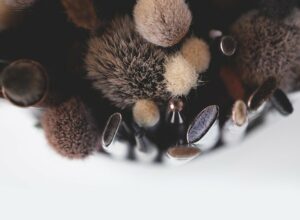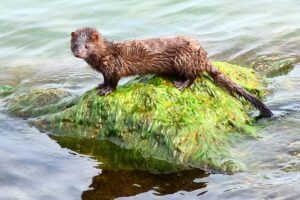Last week, we listed 14 of the most common animal-derived ingredients you are likely to find in your make up, skincare products and shampoos. Here we detail 14 more;
15) Animal hair / bristles
There are a number of different products where you might find animal fur in your cosmetics, from false eyelashes, (which can contain mink fur) to your make-up brushes, where the hair may come from goats, sable, mink, horses, foxes and squirrels). These might be labelled as ‘natural’ brushes – and often as in the case of the brand ‘Too Faced’ – might also be labelled ‘cruelty-free’! (Two-faced indeed!) E.LF. Cosmetics on the other hand, swapped all their 50-dd styles of make-up brush to synthetic versions several years ago.
Boar bristles are commonly found in hairbrushes, dry-skin body brushes and even toothbrushes.
16) Sérica powder
Used as a humectant and conditioner, and sometimes as a bulking agent, it can be found in haircare products, facial cleansers and other skincare and makeup products. But what is sérica powder? It’s actually finely ground silk, – for which silkworms are boiled alive.
17) Mucin / Helix Aspersa Muller Glycoconjugate (Snail Slime). Also listed as ‘Snail Filtrate’, ‘Snail Serum’, and even ‘Snail Oil’.
A staple in popular Korean skincare regimes, there are entire brands, such as ‘Dr. Organic’ now dedicated to the ‘harvesting’ and selling of the slimy substance excreted by snails. For this reason, a product containing the mucus will usually advertise the fact loud and proud. Snail slime, or mucin, to give its proper name, contains antioxidants and hyaluronic acid and stimulates collagen and elastin production in the skin. There are conflicting versions as to how it is obtained from the snails, with ‘saltwater baths’ frequently being suggested. Either way, this is an ingredient that vegans do not want in their products.
18) Pearl and Mother of Pearl (Nacre)
Pearl and mother of pearl powder comes from those pearls that are too low-grade to be used in expensive jewellery, but also from the shells of oysters and other molluscs whose shells have a lustrous, radiant quality. The shells (which are formed from calcite, (calcium) and aragonite, with conchiolin, a protein, (from ‘conch’ = shell) are crushed into a fine powder which can then be mixed with other substances. It’s used in cosmetics such as eyeshadows, lip gloss, lipstick, blush, light-reflecting foundations and nail polishes. The method of obtaining the pearls involves farming the oysters, injecting them with irritants to get them to produce more pearls, (as pearls form as a protective mechanism), and then prizing the shells open to take out the pearls. Oyster sentience is in question, but for vegans, pearls are not an ingredient most of us want to find in our cosmetics.
19) Retinol / Retinoids / Retinyl Palmitate/Tretinoin / Vitamin A
Ah retinol! That most wondrous of youth restorers! Retinol really is a miracle worker, and most skincare experts and cosmetic surgeons around the globe will not hesitate to recommend it for fixing a variety of ills that show the signs of ageing. It lightens sunspots, reverses sun damage, promotes collagen growth and cell turnover (which is important for younger-looking skin), it erases fine lines and it can dramatically improve the appearance of deeper wrinkles. We’re big fans of it here! (The non-animal derived versions of course!) Retinoids are usually the ones to look out for in ingredients lists, as these are normally animal-derived, but retinols, on the other hand, tend not to be. Bear in mind however, that there are many different forms and they will be found under different names, including versions of ‘retinol’. To be on the safe side, purchase retinol-containing creams and serums from those featured on Veganeur.com or do your research beforehand.
20) Squalene / Squalane
This lipid and emollient, which contains antioxidants, is very good for the skin. In fact our skin also contains some naturally occurring squalene. It’s found in moisturisers and body lotions and some haircare products. Squalene used to be known as ‘shark liver oil’, because that’s exactly what it was. These days it is uncommon to find that squalene has come from this source, due to many species of sharks having been hunted to near extinction, and so now most versions of it are in fact plant-based, coming from things like olives, sugarcane, wheat germ and rice bran. Squalane is the more stable version which doesn’t degrade as quickly. Whilst not as likely to be from animal sources as most of the ingredients on this list, it’s always worth checking, and to be sure, buying vegan certified.
21) Sodium Chondroitin Sulfate / Chondroitinsulfate-Gemisch/ Natriumsalze/ Natrium-Chondroitinsulfat/ Sodium Chondrotoin
Another ingredient found in connective tissue, e.g. skin, bone and cartilage, (and therefore mostly sourced from cow cartilage) is commonly found in skincare such as anti-aging creams, moisturisers, some lipsticks and lip plumpers, wrinkle-fillers and even concealers.
22) Glucosamine / Glucosamine sulfate / N-acetyl glucosamine
Another naturally occurring compound within skin, glucosamine is one of the primary components of hyaluronic acid. Some studies have shown that topical applications can boost the production of hyaluronic acid, plumping and smoothing skin to help combat wrinkles and even lightening pigmentation or sunspots caused by the sun. It’s no surprise then that it’s an ingredient in a lot of anti-aging creams, eye-creams and moisturisers, but, as with the other ingredients here, it’s taken from animal sources, primarily crab and shrimp shells.
23) Lactoferrin
Lactoferrin is a protein derived from milk, more often cows’ milk due to it having the second-largest concentration after human milk, and of course, the dairy industry. It’s used in products designed to condition the skin and hair, so shampoos and conditioners, face masks, moisturisers, cleansers, etc, sun blocks and after sun lotions, and sometimes, even in toothpaste.
24) Astaxanthin
A carotenoid sourced from shrimp, lobster, salmon, trout, crayfish and crab, which gives them their red and pink colour tones. Within cosmetic applications it’s used to increase moisture, protect against sun damage (as it helps to block UV rays), and aid in the retention of skin elasticity. For these reasons it’s often an ingredient in moisturisers, anti-aging creams, cleansers, skin serums, eye creams and the like. The good news is, it is also found in algae and yeast, so it is possible to experience the benefits without the cruelty!
25) COQ10/ Co-Enzyme Q10 / Ubiquinol
There are 2 types of Coenzyme Q10 present in all animal tissues, human included, with the highest concentrations in the organs, in particular the heart and liver. They are ubiquinone and ubiquinol. They are antioxidants and play a vital role in the production of ATP, which every cell in the body uses to provide energy. As with everything cellular, our natural concentrations of COQ10 decline with age and though an actual deficiency is rare, it’s recommended that older people, those taking statins and some other drugs, take supplements. Because it’s necessary for the correct function of every cell, it’s not surprising that many skincare companies include it in their day and night creams, anti-aging serums and lotions, eye-creams, and shampoos. But you don’t have to miss out on the benefits, as vegan versions do exist. COQ10 is also naturally found in spinach, cauliflower, broccoli, oranges, strawberries, peanuts, soybeans and lentils.
26) Albumin / Serum Albumin / Bovine Serum Albumin
Sometimes from eggs and sometimes BSA – Bovine Serum Albumin, from bovine blood are used in cosmetics such as face creams, since it has a skin tightening effect (albeit temporary), and as a humectant in body lotions, make-up and sunscreen. Since the CJD outbreak the use of BSV has been controversial generally due to potential risks of cross-contamination. More recent biotechnology methods have developed recombinant albumin proteins from yeast, and even human serum albumin, – once it has been through the process to turn it into a recombinant protein. However, a quick Google search shows that the use of egg albumin, BSV and Fetal Bovine Serum (FBS) in cosmetic applications is still very common.
We don’t want to link to their sites so we have separated the URLs
https: //www.rmbio.com/cosmetics
https: //cosmetotheque.com/en/2018/10/20/tensor-as-active-ingredient/
https: //www.biophyll.com/
https: //russianpatents.com/patent/224/2247554.html
27) Casein / Caseinate / Sodium Caseinate / CAS No. 65072-00-6
Commonly derived from cow’s milk and whey protein, but also from soya, casein is used primarily in bath oils, tablets and bath salts, and other skincare products which aim to condition the skin.
28) Mink Oil / Palmitoleic Acid
Derived from the fat under the pelts of mink from fur farms, mink oil is used in hairsprays, conditioners, moisturisers and cleansers. Some companies such as L’Oreal are open about using mink oil and sadly there is a big market for it. Others may list it as ‘palmitoleic acid’, which is present in adipose tissues, e.g.
Some palmitoleic acid on ingredients lists may be from Sea Buckthorn or macadamia nuts, which also have high concentrations of it. When in doubt, check with the company or choose a certified vegan product to be sure.




